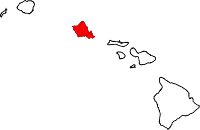Nānākuli, Hawaii
Nānākuli is a census-designated place (CDP) in the Waiʻanae District on the island of Oʻahu, City & County of Honolulu, Hawaii, United States. In Hawaiian, nānā kuli means literally "look at knee". The population was 12,666 at the 2010 census.[1]
Nānākuli | |
|---|---|
 St. Rita Catholic Church in Nānākuli | |
 Location in Honolulu County and the state of Hawaii | |
| Coordinates: 21°23′36″N 158°9′10″W | |
| Country | United States |
| State | Hawaii |
| Area | |
| • Total | 6.6 sq mi (17.0 km2) |
| • Land | 3.0 sq mi (7.7 km2) |
| • Water | 3.6 sq mi (9.3 km2) |
| Elevation | 10 ft (3 m) |
| Population (2010) | |
| • Total | 12,666 |
| • Density | 1,900/sq mi (750/km2) |
| Time zone | UTC-10 (Hawaii-Aleutian) |
| Area code(s) | 808 |
| FIPS code | 15-53900 |
| GNIS feature ID | 0362575 |
Geography
Nānākuli is located at 21°23'36" North, 158°9'10" West (21.393450, -158.152802)[2] near the southern end of the Waiʻanae mountain. Although most of the residents live in the valley, access is from Farrington Highway running along the coastline between Lualualei to the northwest and Kahe then Kapolei to the southeast.
According to the United States Census Bureau, the CDP has a total area of 6.6 square miles (17.0 km2), of which 3.0 square miles (7.7 km2) is land and 3.6 square miles (9.3 km2) is water. The total area is 54.48% water.[3]
Demographics
As of the census of 2000, there were 10,814 people, 2,324 households, and 2,096 families residing in the valley. The population density of Nānākuli was 4,287.6 inhabitants per square mile (1,656.9/km2). There were 2,504 housing units at an average density of 992.8 per square mile (383.7/km2). The racial makeup of the CDP was 5.70% White, 0.79% Black or African American, 0.29% Native American, 11.61% Asian, 40.21% Pacific Islander, 0.83% from other races, and 40.59% from two or more races. 11.12% of the population were Hispanic or Latino of any race.
There were 2,324 households in Nānākuli, out of which 46.0% had children under the age of 18 living with them, 58.8% were married couples living together, 22.3% had a female householder with no husband present, and 9.8% were non-families. 6.7% of all households were made up of individuals, and 2.0% had someone living alone who was 65 years of age or older. The average household size was 4.65 and the average family size was 4.74.
In the CDP the population was spread out, with 35.8% under the age of 18, 11.4% from 18 to 24, 27.4% from 25 to 44, 18.5% from 45 to 64, and 6.9% who were 65 years of age or older. The median age was 27 years. For every 100 females there were 99.0 males. For every 100 females age 18 and over, there were 92.8 males.
The median income for a household in Nānākuli was $45,352, and the median income for a family was $45,677. Males had a median income of $30,722 versus $24,731 for females. The per capita income for the CDP was $11,690. 21.3% of the population and 19.2% of families were below the poverty line. Out of the total population, 26.7% of those under the age of 18 and 9.6% of those 65 and older were living below the poverty line.
Nānākuli, DHHL, and the Native Hawaiian Community
Nānākuli is home to one of the oldest Hawaiian Home Land Divisions established through the Native Hawaiian Homes Commission Act of 1921, promoted by Prince Jonah Kūhiō Kalanianaʻole.[4] The presence of DHHL (Department of Hawaiian Home Lands) has heavily influenced the Nānākuli community. Uniquely in the state of Hawaiʻi and for the last 50 years, three Nānākuli public schools have campuses located on Hawaiian Home Lands. These are Nānākuli High and Intermediate, Nānā I Ka Pono, and Nānākuli Elementary.[5] Within the last two decades, Native Hawaiian based learning has been offered for students of the valley; at Nānākuli Elementary, kids can join a Hawaiian language Immersion program (Kula Kai O Puni). Aside from the Department Of Education, there also exists Ka Waihona O Ka Naʻoʻao Hawaiian Public Charter School. In recent years, the neighborhood board acknowledged the long-standing history of the valley and DHHL by renaming Nānākuli Beach Park after Kalaniʻanaole.[6] Some other Native Hawaiian organizations that have reached out to this community are The Liliʻuokalani Trust (Formerly known as the Queen Liʻliʻuokalani Children’s Center), The Office Of Hawaiian Affairs, and Kamehameha Schools. Only 3,970 reported residents identify with having some sort of Hawaiian ancestry out of the approximate population of 12,000.
Education
The Hawaii Department of Education operates the public schools. Two elementary schools, Nanaikapono and Nanakuli, and the Nanakuli High & Intermediate School are in the CDP.[7]
Notable residents
References
- "Profile of General Population and Housing Characteristics: 2010 Demographic Profile Data (DP-1): Nanakuli CDP, Hawaii". United States Census Bureau. Retrieved May 24, 2012.
- "US Gazetteer files: 2010, 2000, and 1990". United States Census Bureau. 2011-02-12. Retrieved 2011-04-23.
- "Geographic Identifiers: 2010 Demographic Profile Data (G001): Nanakuli CDP, Hawaii". United States Census Bureau. Retrieved May 24, 2012.
- A BROKEN TRUST, The Hawaiian Homelands Program, Hawaii Advisory Committee to the United States Commission on Civil Rights
- A BROKEN TRUST, The Hawaiian Homelands Program, Hawaii Advisory Committee to the United States Commission on Civil Rights
- NA MAKAMAKA O NANAKULI, Ronald Gallimore and Alan Howard, Bishop Museum, December 1991
- "Nanakuli CDP." U.S. Census Bureau. Retrieved on October 7, 2020.
- "Radasha Ho'ohuli Archived 2007-10-21 at the Wayback Machine." MidWeek. Retrieved on May 21, 2009.
